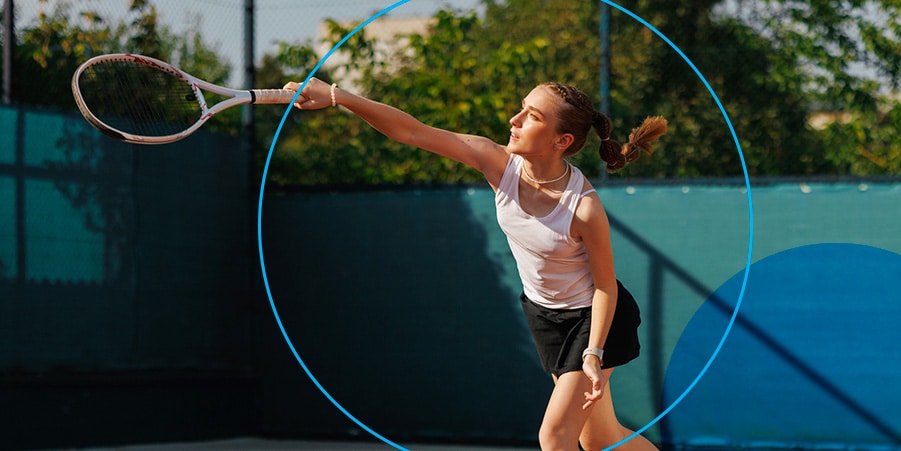Preventing Sports Injuries in Young Athletes
Youth sports build physical fitness while teaching teamwork and discipline. However, taking part in sports increases the risk of injury. More than 3.5 million American children under 14 get hurt each year. These injuries sideline young athletes, impact their confidence and may affect their long-term health.
Understanding the risks and taking proactive steps to prevent sports injuries in children can encourage them to keep playing safely. That way, they can enjoy the activities they love into adulthood.
Most Common Young Athlete Injuries
Youth sports injuries are caused by numerous factors, including repeated trauma and overuse, growth spurts, ill-fitting equipment, poor technique and insufficient rest. Consequences include:
- Sprains and strains: These are the most common injuries, often affecting ankles, knees and wrists when sudden movement or falls cause ligaments or muscles to stretch or tear.
- Growth plate injuries: Growth plates are areas of developing tissue at the ends of long bones. Injuries here can affect bone growth and are more serious in children than adults.
- Overuse injuries: Repetitive motions like pitching in baseball or running long distances can lead to stress fractures, tendonitis and shin splints.
- Concussions: Head injuries can occur in contact sports like football or soccer. Even mild concussions require careful management to prevent long-term effects.
- Heat-related illnesses: Young athletes are at risk for heat exhaustion and heatstroke, especially during intense activity in hot weather.
Strategies for Youth Sports Injury Prevention
Preventing sports injuries in children and teens requires a proactive, comprehensive approach.
Regular Physical Examinations
An annual checkup with a health care provider can identify any underlying health issues and ensure each child is physically ready to participate in sports activities.
Proper Warmup and Cooldown Routines
Build proper warmup and cooldown routines into every practice and game. Dynamic stretching before activity helps prepare muscles for movement, while static stretching after exercise aids in muscle recovery and reduces the risk of injury.
Age-Appropriate Training
Young athletes should not only rely on their chosen sport to get in shape. Following a strength and conditioning program of exercises designed for their specific age and sport helps prevent overexertion and minimizes the likelihood of injury. Closely supervised by their coach, a weight-training regimen may help youth prepare for athletic activities.
Rest and Recovery Periods
Understanding adequate rest and recovery techniques for athletes is crucial for preventing overuse injuries in youth sports. Schedule regular rest days, and make sure young athletes get sufficient sleep to allow their muscles to repair and support overall health.
Female Athlete Triad
Physically active girls can be affected by three interrelated issues:
- Low energy availability with or without disordered eating
- Menstrual dysfunction
- Decreased bone mineral density with health consequences like stress fractures and osteoporosis
Coaches, parents and health care providers can work together to educate athletes about the risks and promote a balanced approach to training, nutrition and rest.
Protective Gear for Youth Sports
Athletes should always wear sport-specific, well-fitted gear, like helmets, pads and supportive footwear, to protect themselves from common injuries associated with their sport.
Safety Equipment Guidelines
Using the right equipment and following safety guidelines are essential for injury prevention:
- Helmets, mouthguards, pads and braces should be used as recommended for each sport.
- Ill-fitting gear can increase injury risk. Check regularly that everything fits as the athlete grows.
- Youth sports protective gear should be inspected for wear and replaced as needed to maintain protective qualities.
- Sticking to sport-specific rules — like limits on contact or pitch counts — reduces injury risk.
- Check fields, courts and gyms regularly for hazards like holes, debris or slippery surfaces.
5 Training and Conditioning Tips
A well-rounded training program is key to injury prevention and athletic development. It involves:
1. Proper Technique
Getting instruction from qualified coaches means young athletes develop safe movement patterns from the start. Consistent reinforcement of good technique can help athletes perform better and prevent sports injuries in children.
2. Strength Training Guidelines
Well-designed strength training routines for young athletes focus on proper form and controlled movements rather than heavy weights. Incorporating body weight exercises and resistance bands can safely enhance strength while supporting healthy growth.
3. Flexibility Exercises
Incorporating flexibility exercises into a training routine can help athletes move more efficiently and comfortably during play. Stretching major muscle groups also aids in recovery and reduces post-exercise soreness.
4. Cross-Training Benefits
Engaging in a variety of sports or physical activities challenges different muscle groups and motor skills, leading to more well-rounded athleticism. Cross-training also keeps training fun and can help prevent mental burnout.
5. Gradual Intensity Progression
A slow and steady increase in training demands gives muscles, tendons and bones time to strengthen and adapt. This approach also helps athletes build endurance and confidence without overwhelming their bodies.
Recovery and Return to Play
Proper recovery is vital to prevent re-injury and ensure long-term health. A safe approach to recovery includes:
- Injury assessment protocols: These involve prompt evaluation of an injury by a health care professional and a detailed recovery plan.
- Proper healing time: Rushing back too soon can worsen injuries. It’s important to follow medical advice even if a child can’t wait to get out there again.
- Graduated return to activity: A stepwise approach to resuming sports allows the body to rebuild strength and confidence.
- Medical clearance: Only a qualified provider should clear an athlete to return to play after injury.
- Prevention of re-injury: Ongoing conditioning, sticking to safety guidelines and monitoring for recurring symptoms help keep athletes healthy.
The Role of Adults in Youth Sports Injury Prevention
Adults play a critical role in keeping young athletes safe and healthy. Education and vigilance are key to injury prevention and safe enjoyment of sports.
Here’s how adults can aid in youth sports injury prevention:
- Coaches can prioritize safety, teach proper techniques and create a supportive environment.
- To encourage safe play, parents should first teach their children the importance of healthy participation, adequate rest and good nutrition.
- Health care and physical therapy professionals can provide injury assessment and a recovery regimen to heal and strengthen the body for a safe return to play.
- Open dialogue among coaches, parents, medical professionals and athletes ensures everyone is aware of injury risks and prevention strategies.
- Adults should watch for signs of pain, fatigue or changes in performance, and respond promptly to potential injuries.
Keep Your Young Athlete Safe and Thriving With Expert Care
Prioritizing injury prevention in youth sports delivers lifelong benefits — helping young athletes stay active, confident and healthy. By creating a culture of safety, coaches, parents and health care providers can work together to reduce injury risks and support every child’s athletic journey.
For more information and expert care, contact our podiatrists today or call 360.754.3338. Foot & Ankle Surgical Associates offers resources, education and advanced treatment options to keep your young athlete in the game. Remember, prevention is a team effort — let’s put our best foot forward for the next generation of athletes.





